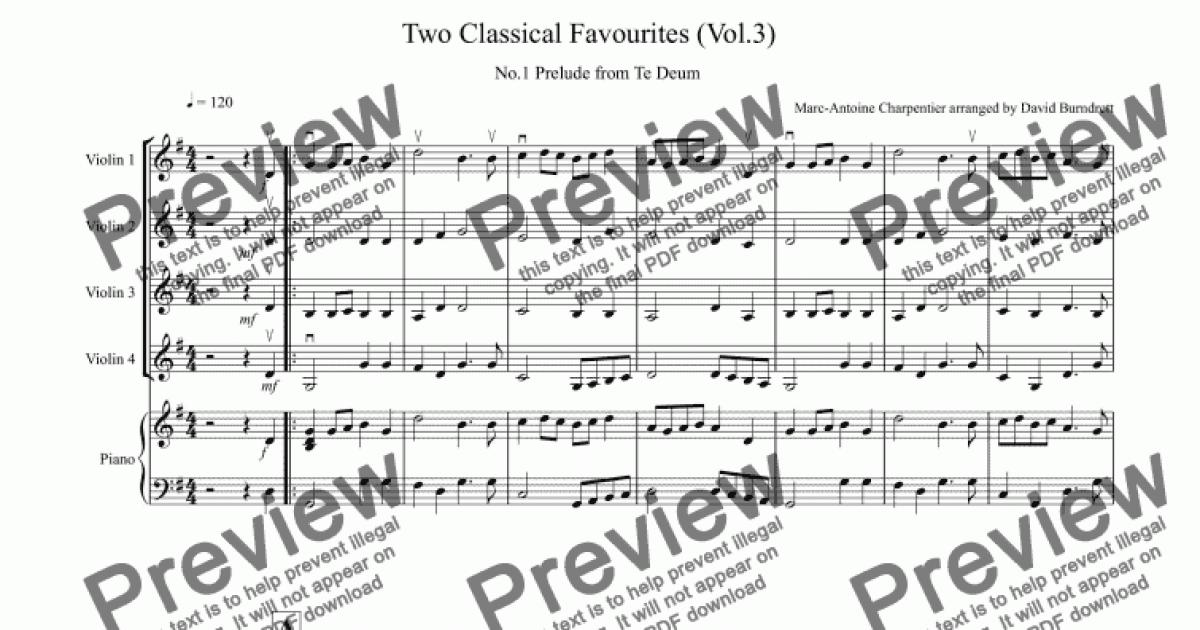Charpentier Prelude From Te Deum Pdf Files
Marc-Antoine Charpentier composed his grand polyphonic motet Te Deum (H. 146) in D major probably between 1688 and 1698, during his stay at the Jesuit Church of Saint-Louis in Paris, where he held the position of musical director. The work is written for the group of soloists, choir, and instrumental accompaniment. Prelude Te Deum M. Charpentier Archiv der kreuznacher-diakonie-kantorei Tromba 7 14 Timpani Violino 1 Flauti Oboi Violino 2 Viola B.c.

Contents • • • • • Structure [ ] The composition consists of the following parts: • Prelude ( Marche en rondeau) • Te Deum laudamus (bass solo) • Te aeternum Patrem (chorus and SSAT solo) • Pleni sunt caeli et terra (chorus) • Te per orbem terrarum (trio, ATB) • Tu devicto mortis aculeo (chorus, bass solo) • Te ergo quaesumus (soprano solo) • Aeterna fac cum sanctis tuis (chorus) • Dignare, Domine (duo, SB) • Fiat misericordia tua (trio, SSB) • In te, Domine, speravi (chorus with ATB trio) Charpentier considered the key D-major as 'bright and very warlike'. The instrumental introduction, composed in the form of rondo, precedes the first verset, led by the bass soloist. The choir and other soloists join gradually. Charpentier apparently intended to orchestrate the work according to the traditional exegesis of the Latin text.

The choir thus predominates in the first part (verset 1-10, praise of God, heavenly dimension), and individual soloists in the second part (verset 10-20, Christological section, secular dimension). In subsequent versets, nos. 21-25, both soloists and choir alternate, and the final verset is a large-scale fugue written for choir, with a short trio for soloists in the middle. Orchestration [ ] The composition is scored for five soloists (SSATB) and choir (SATB), accompanied with an instrumental ensemble of 2 nonspecified recorders or flutes, 2 oboes, 2 trumpets (second trumpet in unison with timpani), timpani, 2 violins, 2 violas ('haute-contres de violon' and 'tailles de violon') and basso continuo. Typical continuo instruments used in French baroque music are 'basses de violon' (a cello-like, large scaled instrument often replaced by the cello in modern performances), organ, harpsichord, theorbo, bass viol and bassoon or 'basse de cromorne' (a kind of bass oboe). Furthermore, serpents were frequently used to double the bass line of vocal choirs in 17th century France. Since the instrumental ensemble is mostly constricted to 4 parts only (wind instruments and violins playing the same line), it is very easy to reduce the instrumentation if needed.
In popular culture [ ] After the work's rediscovery in 1953 by French musicologist, the instrumental prelude, Marche en rondeau, was chosen in 1954 as the theme music preceding the broadcasts of the. After over sixty years of use notably before EBU programs such as the popular and, the prelude, as arranged by and directed by, has become Charpentier's best-known work. The prelude was used for the introduction of the Olympiad films. The prelude was briefly played during King Richard's coronation in the 1995 film. The prelude was played in TV series S02 E02, at Palace of Versailles in 1744, during reign of King Louis XV of France.
References [ ]. Download Video Ceng Zamzam Kalimatuka.
English: Prelude from the Te Deum by Charpentier Date Source This work comes from the non profit U.S. Organization where it is available at the following link: The Musopen website requires all uploaders to 'represent and warrant that content uploaded to the site is in the public domain' (see ). Musopen's own works ( 'Musopen Materials' and 'Musopen Service', not user content or public domain content), are fully copyrighted and may not be used freely as stated in their. Author Ian Dollins Licensing [ ] This file is made available under the. The person who associated a work with this deed has dedicated the work to the by waiving all of his or her rights to the work worldwide under copyright law, including all related and neighboring rights, to the extent allowed by law. You can copy, modify, distribute and perform the work, even for commercial purposes, all without asking permission.





